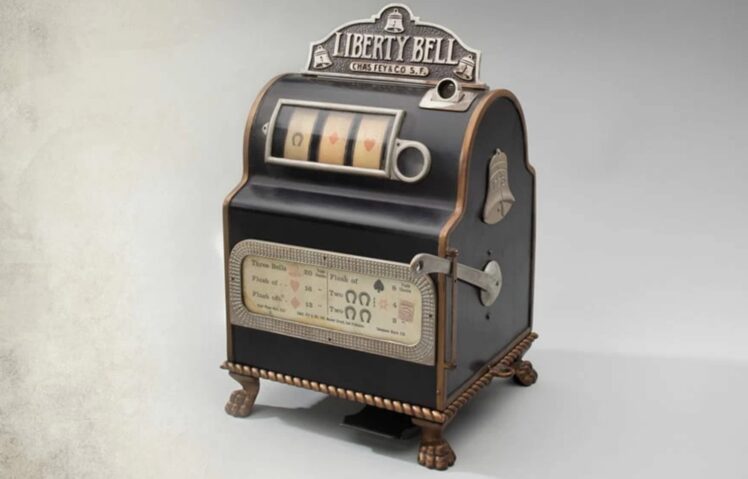Casino slots have come remarkably long from the first rudimentary slot machines invented in the late 19th century. Through revolutionary technological advancements over the past century, simple mechanical slots featuring only three reels and a handful of symbols have transformed into feature-rich, creatively designed video slots with advanced audiovisual effects enjoyed by millions worldwide today.
Contents
- The Inception of Slot Machines
- The Electromechanical Revolution
- The Road to Creativity: The Progression of Video Slots into Sophisticated Games:
- The Meteoritic Rise in Popularity
- The Future of Slots – Virtual Reality, AI, and Mobile Gaming
- Conclusion – The Past, Present, and Future of a Timeless Attraction
The Inception of Slot Machines
The origination of slot machines traces back to 1895 and the invention of the Liberty Bell slot machine. Designed and built by Charles Fey in San Francisco, this early slot machine had three reels and five symbols – horseshoes, diamonds, spades, hearts, and bells. With just 20 potential winning combinations, the Liberty Bell was a far cry from slots found in casinos today, but it pioneered the basic slot machine concept and gameplay.
For decades after, slot machine design remained simple. Most slots mimicked the Liberty Bell with only three reels and limited symbol options. They also lacked advanced components like the ability to automatically payout winnings. Payouts had to be made manually by casino staff. While constrained by primitive technology, these early slots still offered excitement and the chance to win cash prizes. Their simplicity and straightforward gameplay made them popular with customers of all backgrounds.

Source: medium.com
The Electromechanical Revolution
A significant evolution came in the 1960s with the advent of electromechanical slot machines. Bally Technologies developed the first fully electromechanical slot, Money Honey, in 1963. Electromechanical slots could incorporate more reels, symbols, and components like hoppers to automatically payout coins. This allowed for more diverse game designs. The electromechanical era continued through the 1970s. With enhancements like the ability to accept multiple coins per spin, slots became even more profitable for casinos and manufacturers.
The Road to Creativity: The Progression of Video Slots into Sophisticated Games:
The first significant breakthrough came in 1975 when Fortune Coin Company launched the first video slot machine, moving away from mechanical reels to a cathode ray tube screen. This allowed for more creativity in graphics, visual effects, and game features. 1980s random number generators were incorporated to ensure provably fair, unexpected outcomes on each spin. Slots also gained adjustable theoretical payout percentages with this improved software. Video slots became even more advanced during the 1990s, adding interactive bonus rounds and free spin features.
Today’s video slots are highly immersive, using 3D graphics, HD screens, surround sound, and sophisticated visual effects. Games have multiple reels with hundreds of potential winning combinations across 50+ pay lines. Innovations like cascading reels and expanding wilds make each spin unique. Some games have progressive jackpots that can payout over $1 million. Leading developers use cutting-edge features like skill-based shooting mechanics and augmented reality to attract players. There is now an unmatched level of choice with a wide variety of classic, adventurous, and pop culture themes. Video slots continue evolving to deliver an engaging, dynamic experience of creativity and interaction.

Source: godfiregame.com
The Meteoritic Rise in Popularity
In tandem with their innovation, slot machines have exploded in popularity over the decades. A niche attraction in early 20th-century saloons, slots now dominate almost every casino floor and gambling website. Their share of total casino gaming revenue illustrates their towering appeal.
In 2021, over 60% of gaming revenue in American casinos came from slot machines, amounting to a staggering $7.2 billion industry. Comparatively, table games like blackjack and poker generated under $5 billion. Slots represented over 80% of gaming revenue in significant gambling jurisdictions like Macau, Singapore, and Australia.
Driving this surging popularity is the universal accessibility of slots. Unlike skill-based table games, niches revolve purely around chance. No advanced gambling knowledge is needed. With slots, players insert money, push a button, and wait hopefully for matching symbols to line up across a pay line. While not offering the strategy of poker or blackjack, slots provide simple, straightforward play with the potential for substantial jackpot payouts. Just one lucky spin can land a life-changing windfall.
The sheer variety in slot themes and formats today provides endless choices. Players can explore slots based on favorite movies, musicians, celebrities, fantasy characters, video games, comics, TV shows – nearly any intellectual property. This gives places mass appeal across demographics from Gen Z teenagers to baby boomer retirees. Everyone can find slots tailored to their unique interests.
Casinos have also incentivized slot play through rewards programs and complimentary offerings. It is common for slot players to receive free hotel stays, meals, show tickets, and other perks based on their level of play. Combined with exciting gameplay and the chance for oversized payouts, these benefits help make slot machines consistently alluring to patrons.
The Future of Slots – Virtual Reality, AI, and Mobile Gaming
While slots enjoy tremendous popularity, developers are innovating to take the place’s experience into new frontiers. Virtual reality (VR) represents one emerging technology with immense potential. VR slots let players step directly into lavishly detailed casino environments and interact more deeply with games in 3D. VR heightens the escapism and immersion that modern spaces already deliver.
Integration with artificial intelligence (AI) and machine learning is another top priority. Sophisticated AI systems can observe and dynamically optimize game features to match individual player preferences better. This opens the door for hyper-personalized slots. Additionally, predictive algorithms can help developers analyze game performance to pinpoint opportunities for improvement.
Expanding mobile compatibility is also crucial to providing greater convenience and accessibility. Players increasingly use smartphones and tablets for all forms of entertainment, including casino gaming. Developers are prioritizing cross-device versatility and adapting game designs for smaller touchscreens. Larger jackpot payouts incentivize mobile play. Location-based features even let players progress on slot games as they move around in real life.
If you want to experience the thrill of slots from the comfort of your home, visit – https://casinoslotr.com/giris/

Source: canva.com
Conclusion – The Past, Present, and Future of a Timeless Attraction
For over a century, slot machines have demonstrated a spectacular capacity to retain their classic appeal and reinvent themselves through cutting-edge technology. The hypnotic allure of spinning reels and lights first introduced by Charles Fey’s Liberty Bell machine remains intact. But surrounding this nostalgic core is now an endless array of creative formats, themes, and features matching the desires of modern casino patrons.
As slots continue rising in popularity across generations and cultures, the future points to even more versatility through immersive and intelligent gaming. However, no matter how far places progress technologically, their nostalgic spark and elegant simplicity endure. The excitement of hitting the jackpot win with the press of a button represents a timeless, universal thrill that innovative slots builders will continue honoring for the next hundred years and beyond.
